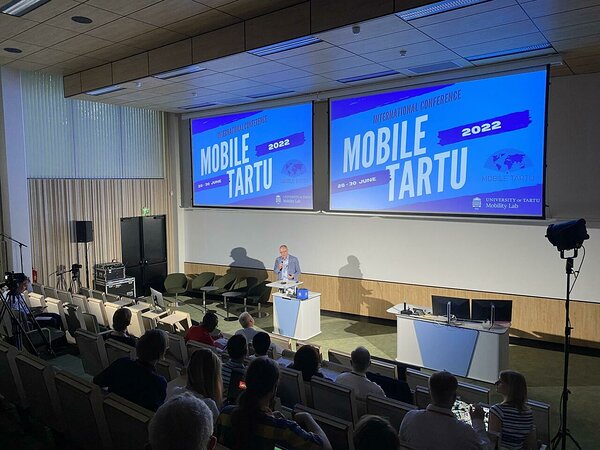Mobile Tartu returned as an in-person event this year. The two-day conference was filled with fascinating lectures, sessions and panel discussions. Various topics related to mobile positioning data (MPD) were analysed, such as, standardising methodologies, mapping out actual places of residence and secondary homes, as well as smoother collaborations between the research community, decision-makers and mobile network operators.
The conference was broad in scope and included a diversity of thoughts and topics. This article presents key takeaways about Mobile Tartu that can be relevant for MPD and that our team thought could be interesting to you. You can watch the recordings of keynote speakers and panel discussions at the official website of the conference https://mobiletartu.ut.ee/
More Focus on Official Statistics
Compared to previous conferences, there was a stronger focus on using MPD for official statistics. This is exciting as it shows that MPD is no longer simply an experimental form of data, but instead a mature data source fit for the purposes of official statistics. As one of the presenters, Charisma Choudhury (University of Leeds), said: “Ten years ago we still needed to convince people that MPD is a good idea, now it is well established.” The focus has shifted away from data access and privacy concerns and more towards the content and best practices – the various exciting applications that MPD can be used for.
One session introduced soon-to-be-released UN methodological guidelines for MPD in five key domains: dynamic population mapping, tourism, migration, disaster management and ICT (a guideline for transportation is also in the works but it was not presented at the conference). These guidelines aim to introduce the methodological aspects, data quality and use cases of MPD to statistical offices, researchers and other people potentially involved in this domain.
These guidelines also seek to help standardise the methods used for MPD and help make adopting MPD for official statistical purposes easier. As panellist Kaja Sõstra from Statistics Estonia said: “The UN guidelines will be very valuable, I can imagine, for statistical offices.”
Analysis Beyond People’s Home Locations
A key takeaway was that one of the shortcomings of traditional data sources in social studies is that they measure people in space based on their home locations. However, a valuable feature of MPD is that it allows measuring people’s movements over the course of a day or week without being tied only to the home location. Much work can be done with MPD exploring the daytime population – where people are located during working hours. For example, in segregation studies, segregation is typically analysed based on which types of people live in which neighbourhoods.
John Östh (Uppsala University) found in his research that there is considerably less ethnic segregation in Stockholm during working hours, and that work locations have more of a social mix compared to home locations. Robert J Sampson from Harvard University found similar results – racial segregation of mobility is not the same as residential segregation. In the case of US cities, he found that different ethnic and class groups move similar distances within the city. What has often not been considered or measured in research is which people visit neighbourhoods that they do not live in.
Similarly, as Mei-Po Kwan explained in her lecture, measuring correlations between people’s physical health and the CO2 emissions in their home neighbourhoods misses the bigger picture of other physical environments that impact people’s health. This is especially important in industrial areas, which tend to have poor air quality. Spending eight hours a day in such an environment might have considerably more effects on a person’s health than living in a less polluted residential location.
Importance of Small Data
While MPD is clearly a form of big data and provides immense possibilities, sometimes it is important to focus on “small data”. As Olle Järv (University of Helsinki) said in his presentation: “Make big data small and meaningful.” A surplus of data can be overwhelming, especially when it comes to using this data to make policy decisions. Mantas Butrimavičius from PositIn pointed out: “Less data is better for the decision-makers, sometimes we provide too much information.” Using tourism studies in Lithuania as an example, he said that sometimes the decision-maker just wants to know which public restrooms to renovate or where to put new road signs. Additionally, compared to big data, small data often simply plays a different, yet very valuable role. As Siiri Silm (University of Tartu) said: “Small data gives more characteristics of the qualitative aspects.”
Malene Freudendal-Pedersen from Aalborg University explained that big data is power, and because of this, it is important to also go beyond that into small data to understand what is happening on the street level or how individuals are affected by various processes. Big data and small data should thus work in synergy to complement each other.
Dynamic Element of Physical Events
The previous Mobile Tartu conference in 2020 was, of course, a virtual event. While this year there were some parts that were accessible virtually, for the most part it was an in-person event. It is highly important to take health and safety seriously in the COVID-19 era, but having the event in person again allowed for a more dynamic exchange of ideas. The conference provided a space for academics, students and others to informally discuss their work and other topics, even if simply during lunch or between lectures. It is important not to understate the value of this informal exchange of ideas. As Raimond Tamm, Deputy Mayor of Tartu, said in the opening of the conference: “Tartu has really been missing face-to-face conferences.” Hopefully being able to meet the various people attending the conference inspired many for valuable future work in the field of mobility!
Would you be interested in learning more about mobile big data and Positium? Let's talk about what mobile big data can do to help your organisation make decisions based on population mobility.
.png)
